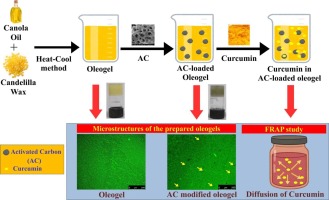Ask for a reprint
email :
* Give your email
2025
ACL
|
Debmalya Banerjee, Gadamsetty Jeevana Lakshmi Kumar, Deblu Sahu, Souvadra Das, Sarada Prasanna Mallick, Gujjala Lohit Kumar Srinivas, Bala Chakravarthy Neelapu, Conchi O.Ania, Arfat Anis, Kunal Pal, 'Activated carbon as a novel crystal habit modifier for oleogels: A study on curcumin encapsulation and diffusion', Colloid Surf. A-Physicochem. Eng. Asp. 724 137414 (2025) doi:10.1016/j.colsurfa.2025.137414
This study investigates the encapsulation of curcumin as a bioactive molecule in candelilla wax/canola oil oleogels loaded with a hydrophobic porous activated carbon (AC) as a crystal habit modifier. A series of oleogels was prepared at the optimized gelling conditions of the wax and oil, and varied amounts of AC (ranging from 0.005 to 0.05 wt%) were incorporated into the formulation. The incorporation of AC progressively reduced the crystallization rates of the oleogels, with the initiation period for primary crystallization decreasing by 4–25 % compared to the pristine oleogel (JC). All the oleogels exhibited high oil binding capacity (OBC) values (close to 100 % in all cases), reflecting their structural stability. Mechanical compression studies further confirmed that the firmness of the oleogels was maintained after the incorporation of the AC. Microscopic observations revealed an increased crystal packing, despite a non-uniform distribution of the AC particles. A progressive darkening of the samples and a concentration-dependent shift in the chromaticity coordinates towards the blue-magenta region (x: 0.34, y: 0.38) was found as the amount of AC was raised to 0.05 wt%. Hyperspectral imaging showed a spatial distribution of pixels, characteristic of materials with anisotropic optical properties. Incorporating AC in the oleogels did not significantly modify the diffusion or the relaxation constants of encapsulated curcumin, demonstrating a uniform diffusion of the bioactive molecule regardless of the amount of AC. As opposed to other carbon modifiers, using a hydrophobic activated carbon with a 3D porous network assures the diffusion of curcumin in the oleogel matrix.
|

|